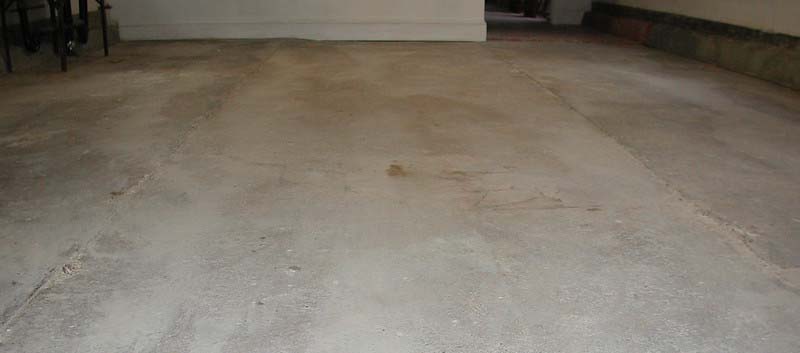How to Seal Concrete Floor from Moisture

Water seeping through basement concrete floors can leave your home susceptible to big problems. This can affect the structural integrity of your Royal Oak home and be a catalyst for unhealthy mold and mildew growth. With constant exposure to moisture, a small crack in a concrete wall over time can morph into a big problem, allowing insects and the elements into your house.
Sealing your home’s concrete surfaces is an important type of preventative maintenance. The concrete slowly breaks down. If you ever notice, there always seems to be dust in various areas with concrete floors. That’s because the surface of concrete continues to slowly flake off over time, creating the dust. Also, concrete can be easily stained. , A little oil drip can stay forever.
Sealing is the perfect option for all scenarios. It will help make your concrete stronger, increase its stain and slip resistance, and make old, gray flooring become more attractive and appealing.
When the time comes to do home repairs, most people should consider whether or not you should hire professionals or do the job themselves. Many will try to do the work themselves. They think they can do the same work as a contractor, except for a fraction of the cost. But if you aren’t experienced in home renovations, you may not have the skills, knowledge, or experience to do the job correctly.
Trained professionals understand what all needs to be done in order to seal your concrete. From fixing cracks and trouble spots to understanding the best sealers for the job, they can give you the advice you need to make a lasting impression on your floor. For example, they will know how to fix any damaged concrete without having to replace the whole slab. Additionally, they will be able to treat it properly in order to create the best adhesion of the sealer, which ensures an even and durable coat.
Also, they will be able to get the best products for the job. One example, polyurea floor coatings are exactly what you need in order to seal your concrete and be confident that it will stay looking good for years to come without cracking or being damaged by the changing weather. This type of floor sealer is also great because it can’t be stained, which makes it more robust.
By considering the use of professionals, you can be assured that the finished project will turn out as anticipated.
Do-it-yourselfers need to be careful and not miss areas, apply sealers uneven, or choose bargain products that last for a little while and then begin to break down. If you are comfortable with this type of home renovation, you will want to attack it with the mindset of a pro. Take your time, do it right, and use quality products to ensure you get the results you want.
The Right Way To Seal Your Basement Floor
There are four key steps to sealing a basement floor the right way: 1) selecting the appropriate sealant, 2) cleaning the surface, 3) fixing cracks, and 4) sealant application.
There are a variety of sealers, so it’s important to select the one that’s best for your project. Here are the options available for concrete surfaces:
- Acrylic Sealer – This easy-to-apply sealer is best for basements and other concrete floors that will not come into contact with oil or grease. Acrylic sealer sits on top of the concrete instead of seeping in, which makes it ideal for sealing interior floors.
- Epoxy sealer – More durable than acrylic, this type of sealant protects against grease and oil and is perfect for a basement, garage or outdoor shed. There are also a few color varieties so you can select your own finish.
- Polyurethane sealer – This type of sealer has a more durable finish than acrylic and epoxy sealer, and it also has UV protection. It’s often used as an overcoat for an epoxy sealer in interior indoor concrete surfaces.
- Siloxane sealer – Lasting for up to twenty years, this sealer will penetrate concrete for top protection. This is a common sealant for indoor and outdoor surfaces such as driveways, patios, and garages.
Take the time to thoroughly clean your concrete floors and walls to ensure the space is ready to be sealed. Move all items from out of the area. Sweep up all dirt, dust, and debris away with good quality a broom.
Treat any oil, grease, paint, and other stains on your concrete floors. Use a concrete cleaner onto the floor and use a scrubbing brush or broom to rub it into the concrete. Hose off the floor to rinse the cleaner off the concrete. Allow for proper drying time and draining of the floor. Let your concrete fully dry for 24 hours.
Once clean and dry, locate any cracks or holes in your concrete. Repair them by applying concrete repair caulk. Use a cloth to smooth out the caulk. Let it dry fully according to the manufacturer’s instructions.
Once you‘ve selected your sealant and prepped your surface, you’re ready to apply the sealant. Here are the steps to successfully apply sealant to your concrete surface (two coats are generally recommended):
- Make sure all available windows are open and the area is properly ventilated.
- Apply your sealant with a quality 9″ roller. Use a paintbrush to cut-in, ensuring the corners and edges are properly sealed.
- Let the sealant dry. Make sure to re-read your directions for the recommended drying time. Depending on your product, the waiting time can range from two hours up to two days.
- Apply a second coat of sealant using both the roller and brush. Let the final coat set for the recommended time on the manufacturer’s instructions, before returning all your items back onto the floor.
Done right, sealing your basement floor is a piece of preventative maintenance which will provide a clean, dry and healthy foundation for your home.

